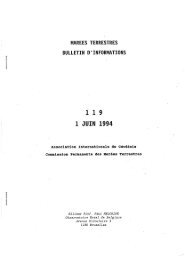marees terrestres bulletin d'informations - Université de la Polynésie ...
marees terrestres bulletin d'informations - Université de la Polynésie ...
marees terrestres bulletin d'informations - Université de la Polynésie ...
Create successful ePaper yourself
Turn your PDF publications into a flip-book with our unique Google optimized e-Paper software.
difference of loading effects of ocean ti<strong>de</strong>s. Japan is surroun<strong>de</strong>d by ocean and seas, and the loading effect in<br />
Japan is extremely <strong>la</strong>rge compared with those in European continent. He consi<strong>de</strong>red this weak point positive<br />
and succee<strong>de</strong>d to estimate the rigidity of Earth’s crust from tidal loading effect at Kamigamo. After<br />
eliminating the tidal loading effect, he obtained the value of D =0.79, which is simi<strong>la</strong>r to those obtained in<br />
Europe, though it was still <strong>la</strong>rger than the expected value.<br />
The name of Shida is famous as the Shida Number in tidal studies. As well known, the tidal response on<br />
the Earth's surface can be represented by three dimensionless parameters in spherical e<strong>la</strong>sticity. They are Love<br />
numbers h and k, and Shida Number l. Love (1909) showed that the disturbing potential can be represented<br />
with sufficient approximation by a spherical harmonic function of the second or<strong>de</strong>r, and all the <strong>de</strong>formations<br />
produced in the Earth by this potential may be represented by the same harmonic function multiplied by a<br />
numerical coefficient suitable for each aspect of the phenomenon. As the numerical coefficients, Love<br />
introduced two parameters (h and k). Shida (1912) pointed out that a third number parameter (l ) should be<br />
necessary to obtain a complete representation of the phenomenon.<br />
The tiltmetric observation started by Shida was succee<strong>de</strong>d by Eiichi Nishimura. He installed the fused<br />
silica tiltmeters of horizontal pendulum type at several stations in Japan and investigated local effects on tidal<br />
tilt observations over many years. In 1941, Nishimura carried out tiltmetric observation at Barim (N48° 18’,<br />
E122°10’, h=790m) in the China continent in or<strong>de</strong>r to obtain an accurate D value (Nishimura, 1950). The<br />
station is distant more than 1000km from the nearest sea. The observation room was in an old copper mine<br />
surroun<strong>de</strong>d by hornfels. Using data obtained from tiltmeters installed at the 70m from entrance of the tunnel<br />
(44m in <strong>de</strong>pth from the surface), Nishimura estimated the following D value;<br />
D =0.661 +/- 0.024<br />
This value was almost corresponding to a theoretically expected value. It took about 30 years to obtaining this<br />
reasonable value after Shida had started the tidal tilt observation at Kamigamo in 1910.<br />
Figure 4. Fused silica tiltmeters of horizontal pendulum type used at the Barim station (upper) and example<br />
of tiltmetric records (lower).<br />
3. Early proposal of observing free oscil<strong>la</strong>tions of the Earth<br />
Existence of free oscil<strong>la</strong>tions of the “e<strong>la</strong>stic” Earth had been theoretically predicted since the <strong>la</strong>tter half<br />
of 19th century. However, observational verification of this had to wait until 1960 when the great Chilean<br />
earthquake of Mw=9.5 occurred off the east coast of Chili.<br />
In or<strong>de</strong>r to observe the free oscil<strong>la</strong>tions of the Earth, it is inevitable to <strong>de</strong>velop the instruments having<br />
high sensitivity in the range of periods from several minutes to 1 hour. Ordinary seismographs are not<br />
sensitive to such long periods. Before the Chilean earthquake of May 22, 1960, following effective<br />
11770



